NCERT Solutions Class 11 Biology Chapter 9 - Biomolecules
Page No. 290 - Intext Questions
Q10.1: Glucose or sucrose are soluble in water but cyclohexane or benzene (simple six-membered ring compounds) are insoluble in water. Explain.
Ans: A glucose molecule contains five −OH groups while a sucrose molecule contains eight −OH groups. Thus, glucose and sucrose undergo extensive H-bonding with water.
Hence, these are soluble in water.
However cyclohexane and benzene do not contain −OH groups. Hence, they cannot undergo H-bonding with water and as a result, are insoluble in water.
Q10.2: What are the expected products of hydrolysis of lactose?
Ans: Lactose is composed of β-D galactose and β-D glucose. Thus, on hydrolysis, it gives β-D galactose and β-D glucose.

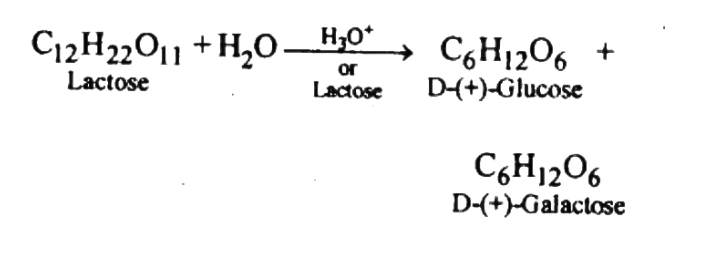
Q10.3: How do you explain the absence of an aldehyde group in the pentacetate of D-glucose?
Ans: D-glucose reacts with hydroxylamine (NH2OH) to form an oxime because of the presence of an aldehydic (−CHO) group or carbonyl carbon. This happens as the cyclic structure of glucose forms an open chain structure in an aqueous medium, which then reacts with NH2OH to give an oxime.

But pentacetate of D-glucose does not react with NH2OH. This is because pentacetate does not form an open chain structure.
Page No. 295 - Intext Questions
Q10.4: The melting points and solubility in water of amino acids are generally higher than that of the corresponding halo acids. Explain.Ans: Both acidic (carboxyl) as well as basic (amino) groups are present in the same molecule of amino acids. In aqueous solutions, the carboxyl group can lose a proton and the amino group can accept a proton, thus giving rise to a dipolar ion known as a zwitter ion.
Due to this dipolar behaviour, they have strong electrostatic interactions within them and with water. But halo-acids do not exhibit such dipolar behaviour.
For this reason, the melting points and the solubility of amino acids in water is higher than those of the corresponding halo-acids [RCH(X)COOH].
Q10.5: Where does the water present in the egg go after boiling the egg?
Ans: When an egg is boiled, the proteins present inside the egg get denatured and coagulate. After boiling the egg, the water present in it is absorbed by the coagulated protein through H-bonding.
Page No. 301 - Intext Questions
Q10.6: Why cannot vitamin C be stored in our body?
Ans: Vitamin C cannot be stored in our body because it is water soluble. As a result, it is readily excreted in the urine.
Q10.7: What products would be formed when a nucleotide from DNA containing thymine is hydrolysed?
Ans: Upon hydrolysis, nucleotide from DNA would form 2-deoxyribose and phosphoric acid along-with thymine.
Q10.8: When RNA is hydrolysed, there is no relationship among the quantities of different bases obtained. What does this fact suggest about the structure of RNA?
Ans: A DNA molecule is double-stranded in which the pairing of bases occurs. Adenine always pairs with thymine, while cytosine always pairs with guanine. Therefore, on hydrolysis of DNA, the quantity of adenine produced is equal to that of thymine and similarly, the quantity of cytosine is equal to that of guanine.
In RNA, there is no relationship between the quantities of four bases (C, G, A and U) obtained, therefore, the base pairing principle, i.e. A pairs with U and C pairs with G is not followed. Therefore, unlike DNA, RNA has a single strand.
Exercises
Q10.1: What are monosaccharides?
Ans: Monosaccharides are carbohydrates That cannot be hydrolyzed to smaller molecules. Their general formula is (CH2O)n Where n=3-7 These are of two types: Those which contain an aldehyde group (-CHO) are called aldoses and those which contain a keto (C=O) group are called ketoses.
They are further classified as trioses, tetroses, pentoses, hexoses, and heptoses according as they contain 3,4,5,6, and 7 carbon atoms respectively. For example.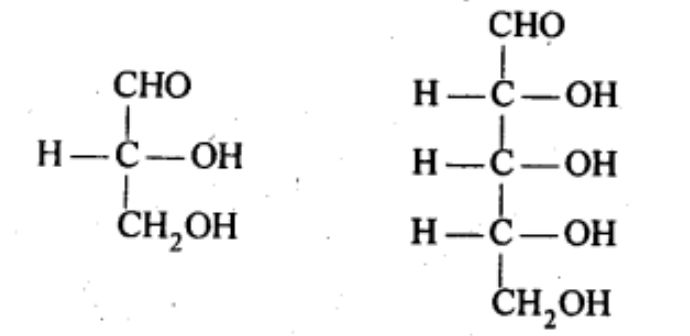
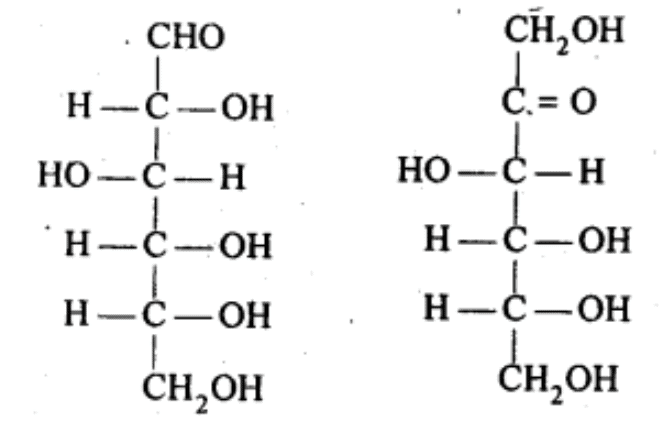
Q10.2: What are reducing sugars?
Ans: Reducing sugars are those that can act as reducing agents. They contain in them a reducing group which may be an aldehydic (-CHO) or ketonic (>C=0) group. The characteristic reactions of reducing sugars are with Tollen’s reagent and Fehling solution. Non-reducing sugars do not give these reactions. For example, glucose, fructose, lactose, etc. are reducing sugars. Sucrose is regarded as a non-reducing sugar because both glucose and fructose are linked through their aldehydic and ketonic groups by glycosidic linkage. Since these groups are not free, sucrose is a non-reducing sugar.
Q10.3: Write two main functions of carbohydrates in plants.
Ans: Two major functions of carbohydrates in plants are the following
(a)Structural material for plant cell walls: The polysaccharide cellulose acts as the chief structural material of the plant cell walls.
(b)Reserve food material: The polysaccharide starch is the major reserve food material in the plants. It is stored in seeds and acts as the reserve food material for the tiny plant till it is capable of making its own food by photosynthesis.
Q10.4: Classify the following into monosaccharides and disaccharides.
Ribose, 2-deoxyribose, maltose, galactose, fructose and lactose
Ans: Monosaccharides:
Ribose, 2-deoxyribose, galactose, fructose.
Disaccharides:
Maltose, lactose.
Q10.5: What do you understand by the term glycosidic linkage?
Ans: Glycosidic linkage refers to the linkage formed between two monosaccharide units through an oxygen atom by the loss of a water molecule.
For example, in a sucrose molecule, two monosaccharide units, ∝-glucose and β-fructose, are joined together by a glycosidic linkage.

Q10.6: What is glycogen? How is it different from starch?
Ans: The carbohydrates are stored in the animal body as glycogen. It is also called animal starch and its structure is similar to amylopectin which means that it is a branched chain polymer of α-D-glucose units in which the chain is formed by C1 – C4 glycosidic linkage whereas branching occurs by the formation of C1– C6 glycosidic linkage. One main difference between glycogen and amylopectin is the length of the chain. In amylopectin, the chain consists of 20 – 25 α – D – glucose molecules whereas in glycogen, there are 10 -14 molecules of α – D – glucose present. Glycogen is more branched than amylopectin. It is present mainly in the liver, muscles, and also in the brain. Glycogen gets converted into glucose when the body needs it with the help of certain enzymes present in the body. Glycogen has also been found to be present in yeast and fungi.
Starch is a major source of carbohydrates which are very much essential to the human body since they supply energy to the body. It occurs as granules mainly in seeds, fruits, tubers and also in the roots of the plants. The chief commercial sources of starch are wheat, maize, rice, potatoes etc.
Q10.7: What are the hydrolysis products of (i) sucrose and (ii) lactose?
Ans: (i) On hydrolysis, sucrose gives one molecule of ∝-D glucose and one molecule of β- D-fructose.

(ii) The hydrolysis of lactose gives β-D-galactose and β-D-glucose.

Q10.8: What is the basic structural difference between starch and cellulose?
Ans: Starch consists of two components − amylose and amylopectin. Amylose is a long linear chain of ∝−D−( )−glucose units joined by C1−C4 glycosidic linkage (∝-link).

Amylopectin is a branched-chain polymer of ∝-D-glucose units, in which the chain is formed by C1−C4 glycosidic linkage and the branching occurs by C1−C6 glycosidic linkage.
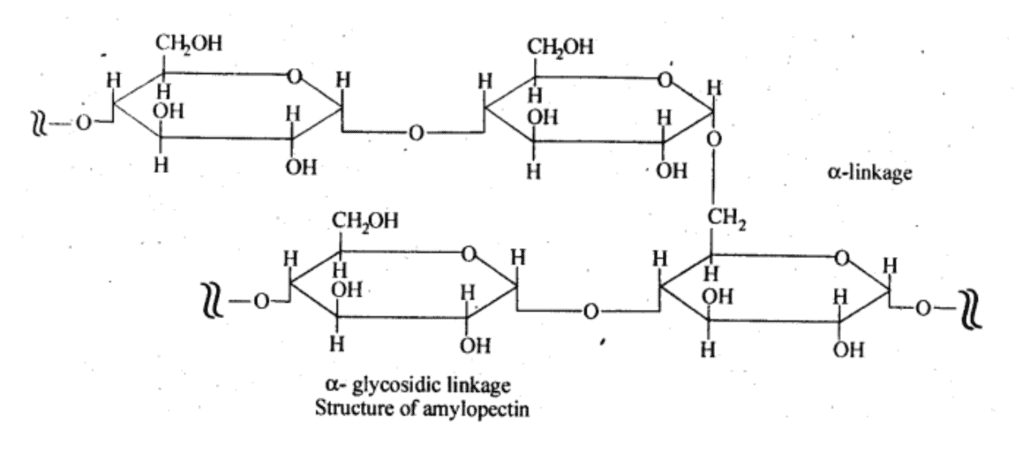
On the other hand, cellulose is a straight-chain polysaccharide of β-D-glucose units joined by C1−C4 glycosidic linkage (β-link).
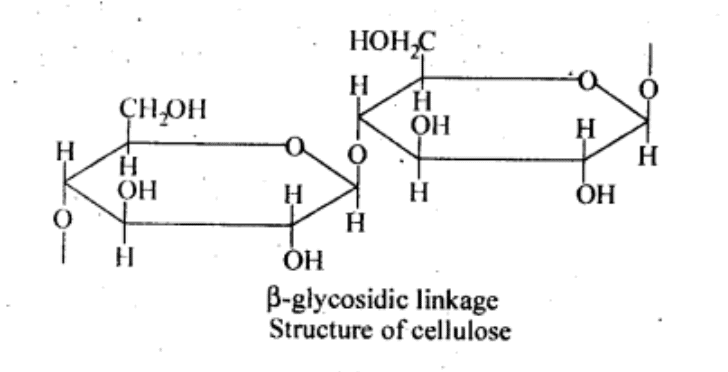
Q10.9: What happens when D-glucose is treated with the following reagents?
(i) HI
(ii) Bromine water
(iii) HNO3
Ans: (i) When D-glucose is heated with HI for a long time, n-hexane is formed.

(ii) When D-glucose is treated with Br2 water, D- gluconic acid is produced.
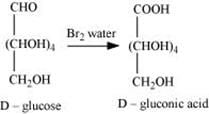
(iii) On being treated with HNO3, D-glucose gets oxidized to give saccharic acid.
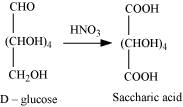
Summary 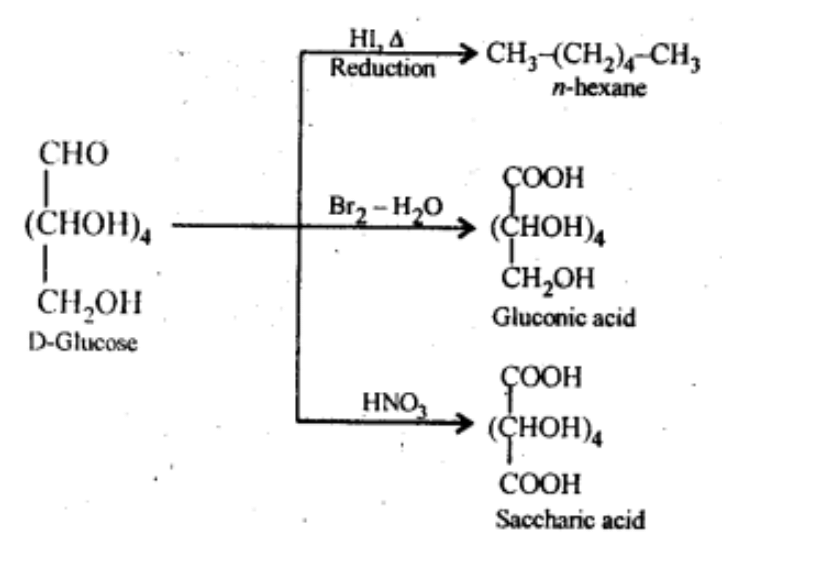
Q10.10: Enumerate the reactions of D-glucose which cannot be explained by its open chain structure.
Ans: The open chain structure of D-glucose contains a free aldehydic group (- CHO). However, it does not give the following reactions:
- D(+) glucose does not react with 2, 4 D.N.P.
- D(+) glucose does not react with NaHSO3.
- D(+) glucose does not restore the pink color to Schiff’s reagent.
- Penia acetyl glucose formed by carrying acetylation with acetic anhydride does not react with hydroxyl amine
(NH2OH) which is the characteristic reaction of all aldehydes. - D( +) glucose is found to exist in two different crystalline forms which are named as α and β. Both these forms have been isolated. For example, α form with m.p. 419 K is obtained by the crystallization of the saturated solution of glucose prepared at 303 K. Similarly, β-form with m.p. 423 K is isolated by carrying out the crystallization of the saturated solution of glucose prepared at 371 K. Apart from that the a-form has a specific rotation (α) equal to + 112° while the β- form has a specific rotation (α) equal to + 19°.
In light of the limitations stated above, Tollen stated that an open chain structure for D(+) glucose is probably not practicable. He proposed a cyclic structure which is a hemiacetal structure. In this structure, the aldehydic (CHO) group
is involved in the form of a ring with the -OH group attached to C5 carbon. It is a six-membered ring, often called ô-
oxide ring. The ring structure accounts for the two isomeric forms and shown below.
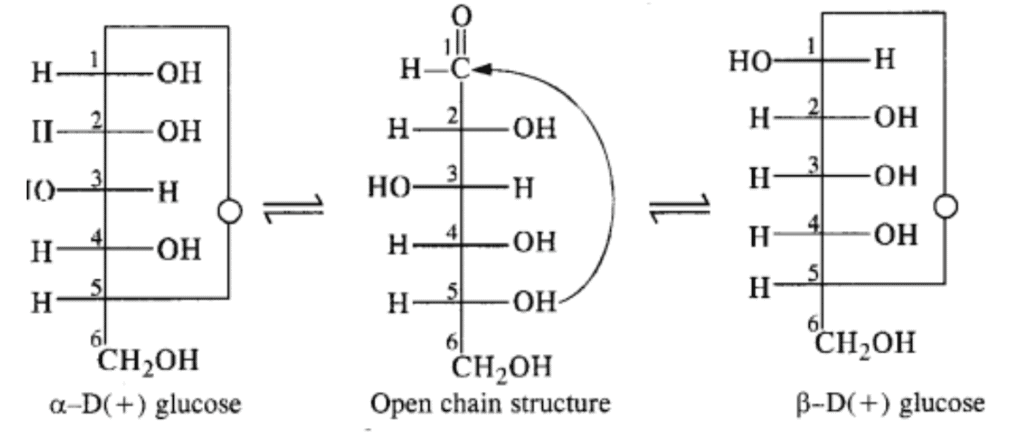
Q10.11: What are essential and non-essential amino acids? Give two examples of each type.
Ans: Essential amino acids are required by the human body, but they cannot be synthesized in the body. They must be taken through food. For example: valine and leucine. Non-essential amino acids are also required by the human body, but they can be synthesized in the body. For example: glycine, alanine, aspartic acid, etc.
Q10.12: Define the following as related to proteins
(i) Peptide linkage
(ii) Primary structure
(iii) Denaturation.
Ans: (i) Peptide linkage:
The amide formed between −COOH group of one molecule of an amino acid and −NH2 group of another molecule of the amino acid by the elimination of a water molecule is called a peptide linkage.
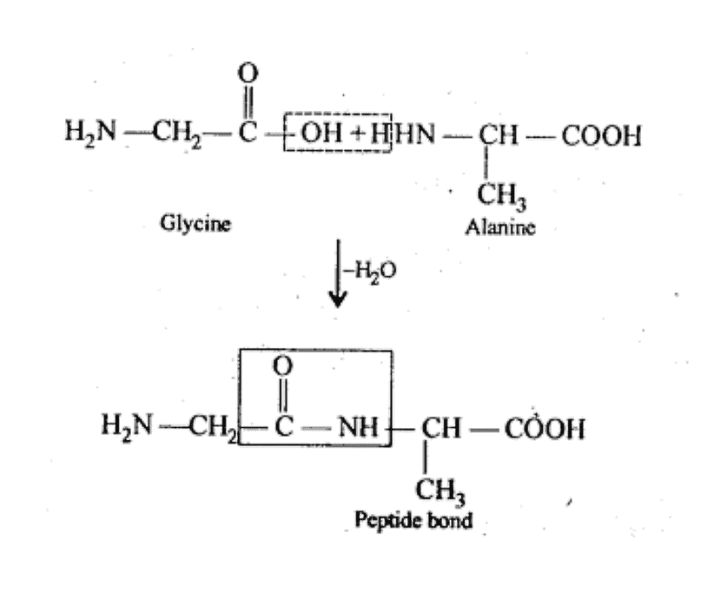
(ii) Primary structure:
The primary structure of protein refers to the specific sequence in which various amino acids are present in it, i.e., the sequence of linkages between amino acids in a polypeptide chain. The sequence in which amino acids are arranged is different in each protein. A change in the sequence creates a different protein.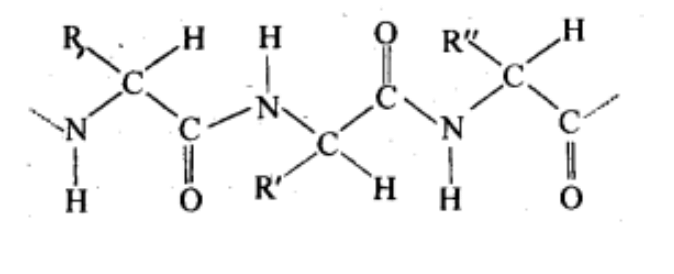
(iii) Denaturation:
In a biological system, a protein is found to have a unique 3-dimensional structure and a unique biological activity. In such a situation, the protein is called native protein. However, when the native protein is subjected to physical changes such as change in temperature or chemical changes such as change in pH, its H-bonds are disturbed. This disturbance unfolds the globules and uncoils the helix. As a result, the protein loses its biological activity. This loss of biological activity by the protein is called denaturation. During denaturation, the secondary and the tertiary structures of the protein get destroyed, but the primary structure remains unaltered.
One of the examples of denaturation of proteins is the coagulation of egg white when an egg is boiled.
Q10.13: What are the common types of secondary structure of proteins?
Ans: There are two common types of secondary structure of proteins:
(i) α-helix structure
(ii) β-pleated sheet structure
α- Helix structure:
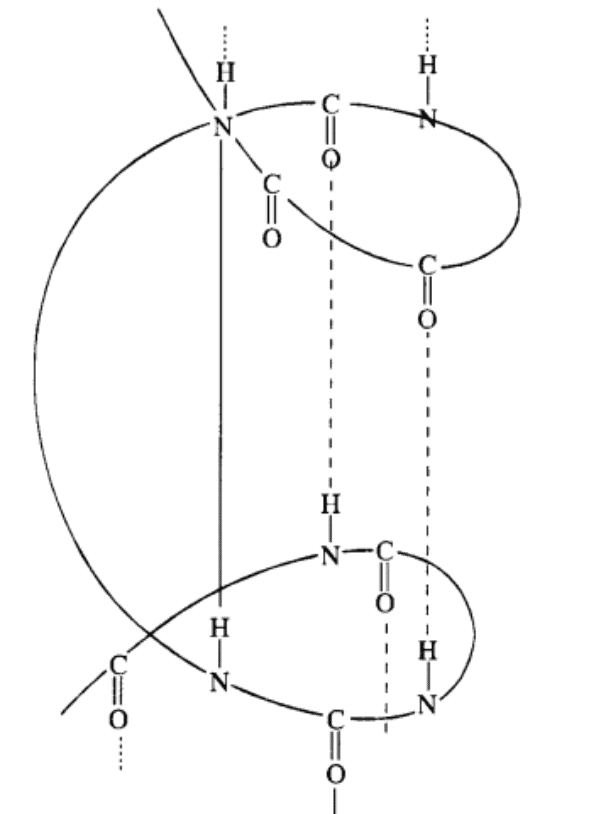
In this structure, the −NH group of an amino acid residue forms H-bond with the  group of the adjacent turn of the right-handed screw (∝-helix).
group of the adjacent turn of the right-handed screw (∝-helix).
β-pleated sheet structure:
This structure is called so because it looks like the pleated folds of drapery. In this structure, all the peptide chains are stretched out to nearly the maximum extension and then laid side by side. These peptide chains are held together by intermolecular hydrogen bonds.
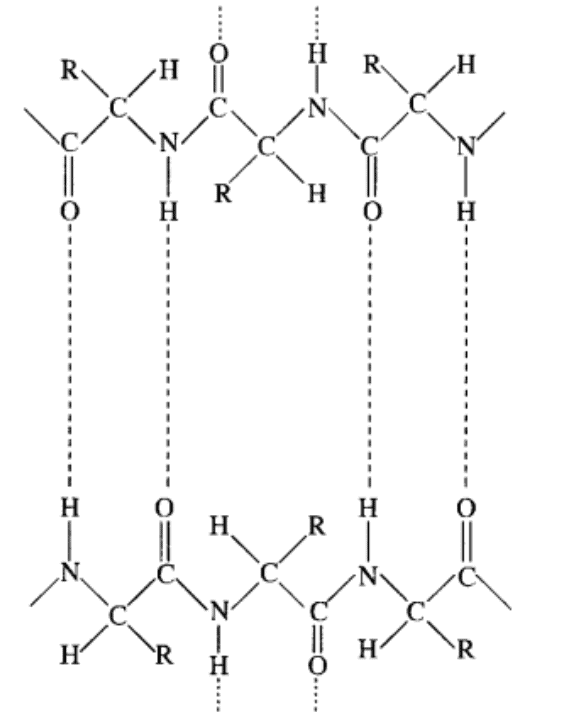
Q10.14: What type of bonding helps in stabilizing the α-helix structure of proteins?
Ans: The H-bonds formed between the −NH group of each amino acid residue and the  group of the adjacent turns of the α-helix help in stabilizing the helix.
group of the adjacent turns of the α-helix help in stabilizing the helix.
Q10.15: Differentiate between globular and fibrous proteins.
Ans: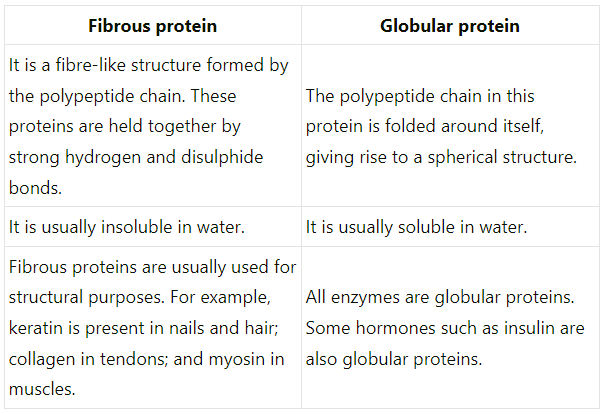
Q10.16: How do you explain the amphoteric behavior of amino acids?
Ans: In aqueous solution, the carboxyl group of an amino acid can lose a proton and the amino group can accept a proton to give a dipolar ion known as zwitter ion.

Therefore, in Zwitter ionic form, the amino acid can act both as an acid and as a base.

Thus, amino acids show amphoteric behavior.
Q10.17: What are enzymes?
Ans: Enzymes are proteins that catalyze biological reactions. They are very specific and catalyze only a particular reaction for a particular substrate. Enzymes are usually named after a particular substrate or class of substrate and sometimes after a particular reaction.
For example, the enzyme used to catalyze the hydrolysis of maltose into glucose is named as maltase.

Again, the enzymes used to catalyze the oxidation of one substrate with the simultaneous reduction of another substrate are named oxidoreductase enzymes.
The name of an enzyme ends with ‘− ase’.
Q10.18: What is the effect of denaturation on the structure of proteins?
Ans: As a result of denaturation, globules get unfolded and helix get uncoiled. Secondary and tertiary structures of protein are destroyed, but the primary structures remain unaltered. It can be said that during denaturation, secondary and tertiary-structured proteins get converted into primary-structured proteins. Also, as the secondary and tertiary structures of a protein are destroyed, the enzyme loses its activity.
Q10.19: How are vitamins classified? Name the vitamin responsible for the coagulation of blood.
Ans: Based on their solubility in water or fat, vitamins are classified into two groups.
(i) Fat-soluble vitamins: Vitamins that are soluble in fat and oils, but not in water, belong to this group. For example: Vitamins A, D, E, and K
(ii) Water-soluble vitamins: Vitamins that are soluble in water belong to this group. For example: B group vitamins (B1, B2, B6, B12, etc.) and vitamin C
However, biotin or vitamin H is neither soluble in water nor fat.
Vitamin K is responsible for the coagulation of blood.
Q10.20: Why are vitamin A and vitamin C essential to us? Give their important sources.
Ans: The deficiency of vitamin A leads to xerophthalmia (hardening of the cornea of the eye) and night blindness. The deficiency of vitamin C leads to scurvy (bleeding gums).
The sources of vitamin A are fish liver oil, carrots, butter, and milk. The sources of vitamin C are citrus fruits, amla, and green leafy vegetables.
Q10.21: What are nucleic acids? Mention their two important functions.
Ans: Nucleic acids are biomolecules which are found in the nuclei of all living cell in form of nucleoproteins or chromosomes (proteins contains nucleic acids as the prosthetic group).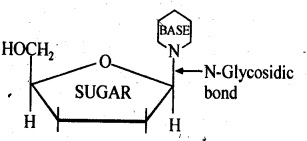 Nucleic acids are of two types: deoxyribonucleic acid (DNA) and ribonucleic acid.(RNA).
Nucleic acids are of two types: deoxyribonucleic acid (DNA) and ribonucleic acid.(RNA).
The two main functions of nucleic acids are:
(a) DNA is responsible for the transmission of hereditary effects from one generation to another. This is due to its unique property of replication, during cell division, and two identical DNA strands are transferred to the daughter cells.
(b) DNA and RNA are responsible for the synthesis of all proteins needed for the growth and maintenance of our body. Actually, the proteins are synthesized by various RNA molecules (rRNA, m-RNA) and t-RNA) in the cell but the message for the synthesis of a particular protein is coded in DNA.
Two main functions of nucleic acids are:
(i) DNA is responsible for the transmission of inherent characteristics from one generation to the next. This process of transmission is called heredity.
(ii) Nucleic acids (both DNA and RNA) are responsible for protein synthesis in a cell. Even though the proteins are synthesized by the various RNA molecules in a cell, the message for the synthesis of a particular protein is present in DNA.
Q10.22: What is the difference between a nucleoside and a nucleotide?
Ans: A nucleoside is formed by the attachment of a base to the position of the sugar.
the position of the sugar.
Nucleoside = Sugar Base
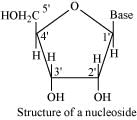
On the other hand, all three basic components of nucleic acids (i.e., pentose sugar, phosphoric acid, and base) are present in a nucleotide.
Nucleotide = Sugar Base Phosphoric acid
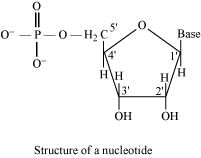
Q10.23: The two strands in DNA are not identical but are complementary. Explain.
Ans: The two strands in a DNA molecule are held together by hydrogen bonds between the purine base of one strand and the pyrimidine base of the other and vice versa. Because of the different sizes and geometries of the bases, the only possible pairing in DNA is G (guanine) and C (cytosine) through three H-bonds, (i.e., C = G) and between A (adenine) and T (thiamine) through two H-bonds (i.e., A = T). Due to this base-pairing principle, the sequence of bases in one strand automatically fixes the sequence of bases in the other strand. Thus, the two strands are complementary and not identical.
Q10.24: Write the important structural and functional differences between DNA and RNA.
Ans: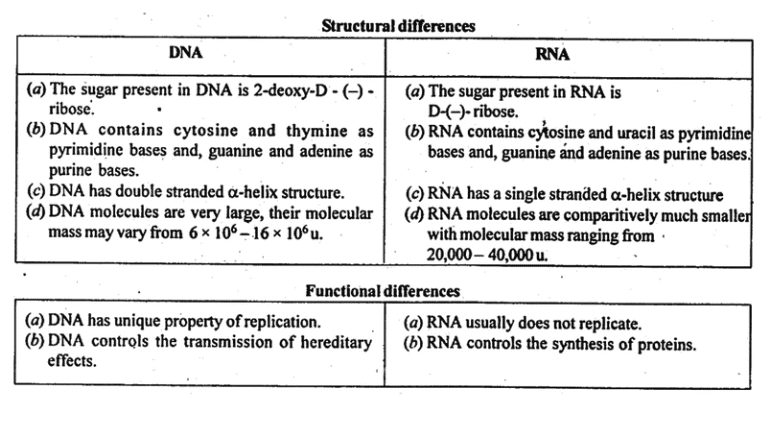
Q10.25: What are the different types of RNA found in the cell?
Ans: (i) Messenger RNA (mRNA)
(ii) Ribosomal RNA (rRNA)
(iii) Transfer RNA (tRNA)
|
75 videos|338 docs|78 tests
|
FAQs on NCERT Solutions Class 11 Biology Chapter 9 - Biomolecules
| 1. What are the four main classes of biomolecules? |  |
| 2. What is the function of carbohydrates in living organisms? |  |
| 3. How are lipids different from other biomolecules? |  |
| 4. What are the building blocks of proteins? |  |
| 5. How do nucleic acids contribute to genetic information? |  |

















